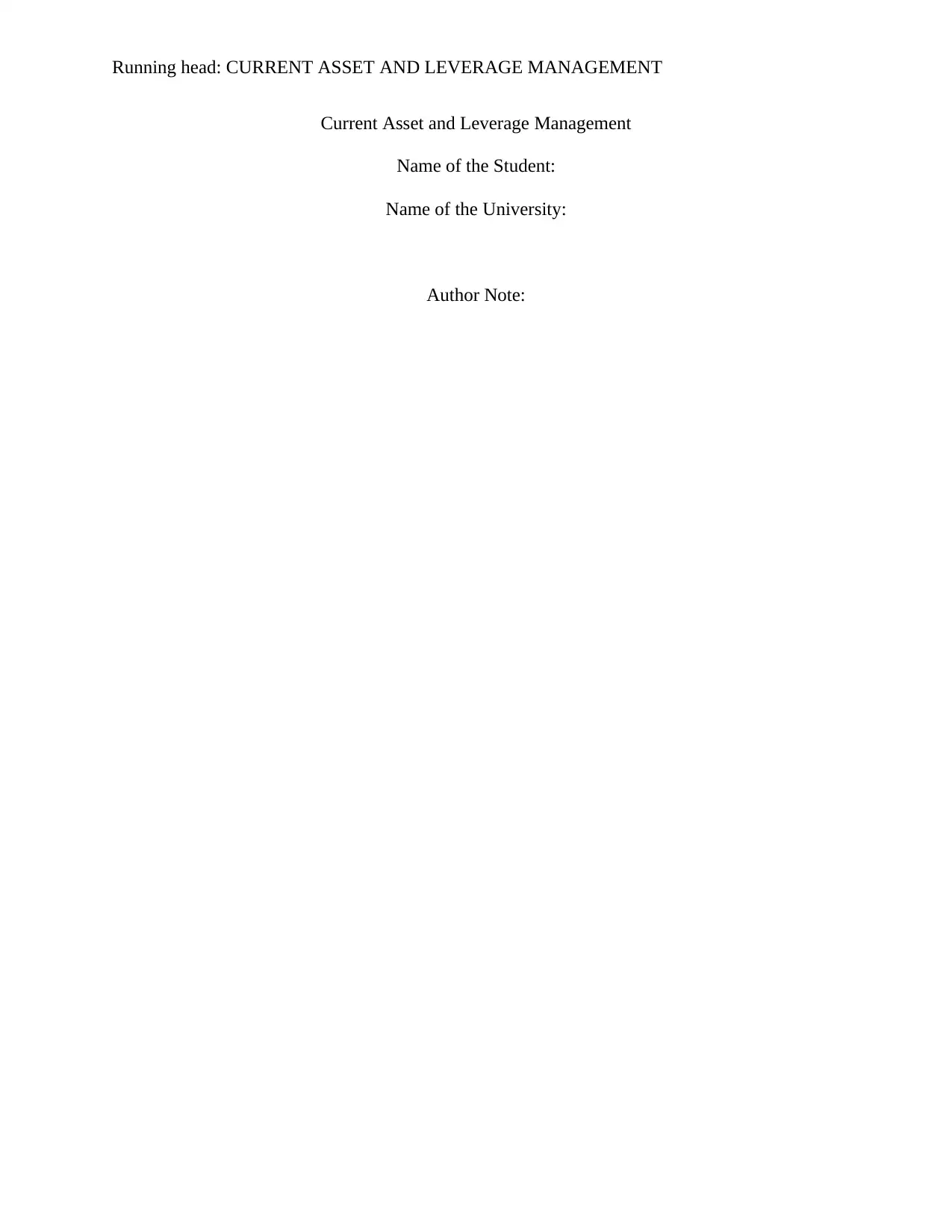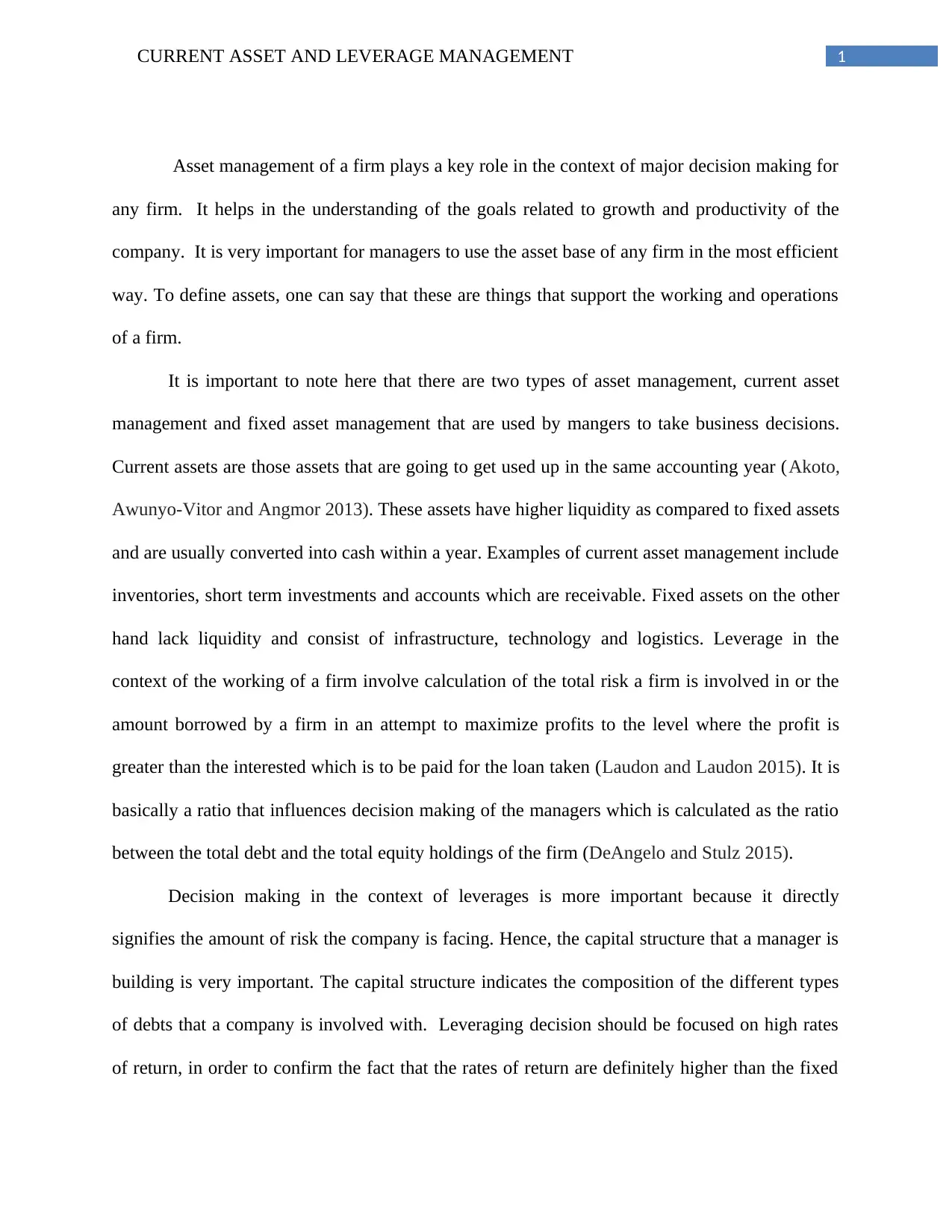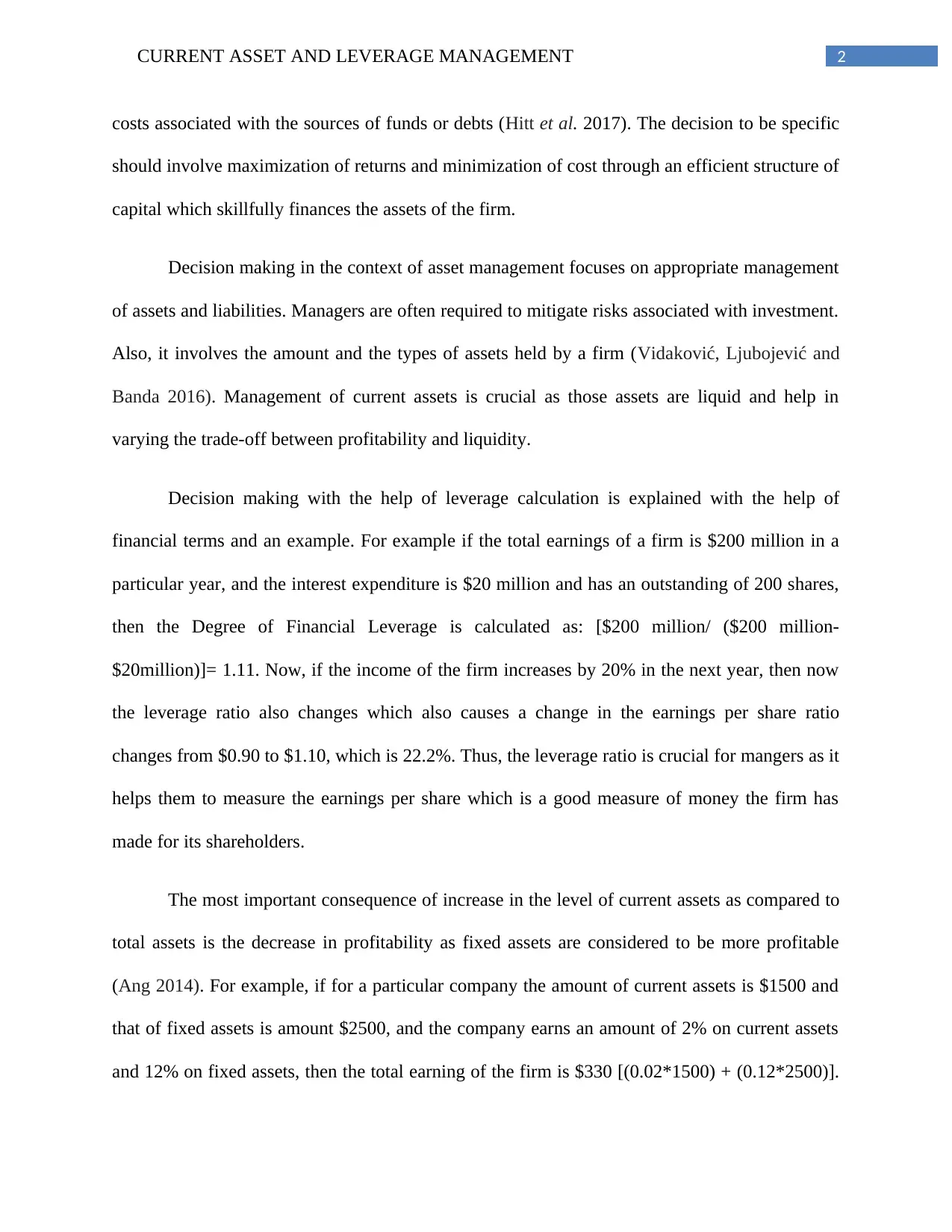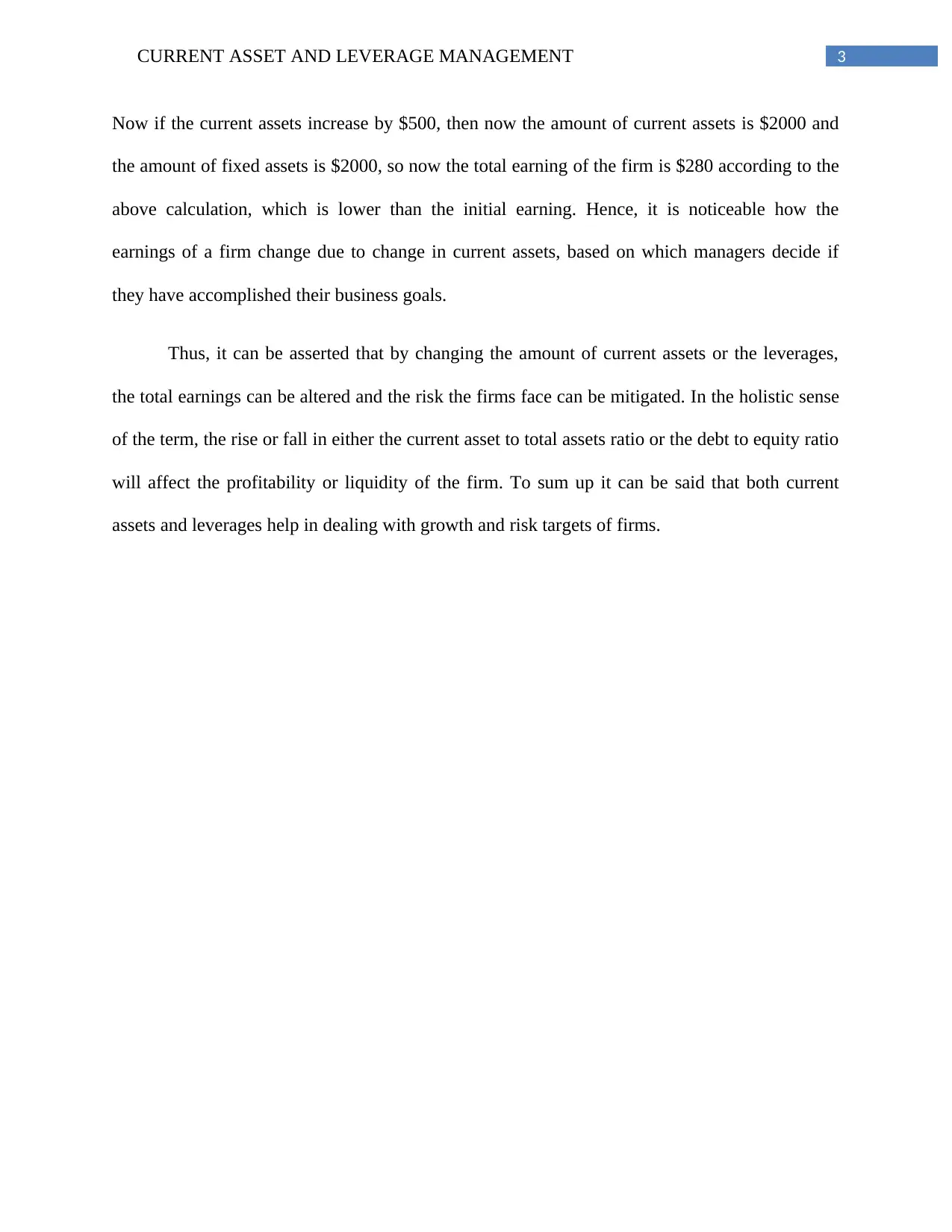Analyzing Current Asset and Leverage Management for Business Growth
VerifiedAdded on 2023/06/14
|5
|1211
|118
Essay
AI Summary
This essay explores the critical roles of current asset and leverage management in a firm's financial decision-making processes. It distinguishes between current and fixed assets, highlighting the liquidity of current assets and their impact on profitability. The essay also examines leverage as a tool for maximizing profits while managing risk, emphasizing the importance of a well-structured capital structure. Through an example, it illustrates how changes in leverage affect earnings per share, a key metric for shareholder value. Furthermore, the essay discusses the trade-off between current and fixed assets, demonstrating how increasing current assets can reduce overall profitability. It concludes that effective management of both current assets and leverage is essential for achieving a firm's growth and risk management objectives, influencing both profitability and liquidity. Desklib provides a platform for students to access similar solved assignments and study resources.

Running head: CURRENT ASSET AND LEVERAGE MANAGEMENT
Current Asset and Leverage Management
Name of the Student:
Name of the University:
Author Note:
Current Asset and Leverage Management
Name of the Student:
Name of the University:
Author Note:
Paraphrase This Document
Need a fresh take? Get an instant paraphrase of this document with our AI Paraphraser

1CURRENT ASSET AND LEVERAGE MANAGEMENT
Asset management of a firm plays a key role in the context of major decision making for
any firm. It helps in the understanding of the goals related to growth and productivity of the
company. It is very important for managers to use the asset base of any firm in the most efficient
way. To define assets, one can say that these are things that support the working and operations
of a firm.
It is important to note here that there are two types of asset management, current asset
management and fixed asset management that are used by mangers to take business decisions.
Current assets are those assets that are going to get used up in the same accounting year (Akoto,
Awunyo-Vitor and Angmor 2013). These assets have higher liquidity as compared to fixed assets
and are usually converted into cash within a year. Examples of current asset management include
inventories, short term investments and accounts which are receivable. Fixed assets on the other
hand lack liquidity and consist of infrastructure, technology and logistics. Leverage in the
context of the working of a firm involve calculation of the total risk a firm is involved in or the
amount borrowed by a firm in an attempt to maximize profits to the level where the profit is
greater than the interested which is to be paid for the loan taken (Laudon and Laudon 2015). It is
basically a ratio that influences decision making of the managers which is calculated as the ratio
between the total debt and the total equity holdings of the firm (DeAngelo and Stulz 2015).
Decision making in the context of leverages is more important because it directly
signifies the amount of risk the company is facing. Hence, the capital structure that a manager is
building is very important. The capital structure indicates the composition of the different types
of debts that a company is involved with. Leveraging decision should be focused on high rates
of return, in order to confirm the fact that the rates of return are definitely higher than the fixed
Asset management of a firm plays a key role in the context of major decision making for
any firm. It helps in the understanding of the goals related to growth and productivity of the
company. It is very important for managers to use the asset base of any firm in the most efficient
way. To define assets, one can say that these are things that support the working and operations
of a firm.
It is important to note here that there are two types of asset management, current asset
management and fixed asset management that are used by mangers to take business decisions.
Current assets are those assets that are going to get used up in the same accounting year (Akoto,
Awunyo-Vitor and Angmor 2013). These assets have higher liquidity as compared to fixed assets
and are usually converted into cash within a year. Examples of current asset management include
inventories, short term investments and accounts which are receivable. Fixed assets on the other
hand lack liquidity and consist of infrastructure, technology and logistics. Leverage in the
context of the working of a firm involve calculation of the total risk a firm is involved in or the
amount borrowed by a firm in an attempt to maximize profits to the level where the profit is
greater than the interested which is to be paid for the loan taken (Laudon and Laudon 2015). It is
basically a ratio that influences decision making of the managers which is calculated as the ratio
between the total debt and the total equity holdings of the firm (DeAngelo and Stulz 2015).
Decision making in the context of leverages is more important because it directly
signifies the amount of risk the company is facing. Hence, the capital structure that a manager is
building is very important. The capital structure indicates the composition of the different types
of debts that a company is involved with. Leveraging decision should be focused on high rates
of return, in order to confirm the fact that the rates of return are definitely higher than the fixed

2CURRENT ASSET AND LEVERAGE MANAGEMENT
costs associated with the sources of funds or debts (Hitt et al. 2017). The decision to be specific
should involve maximization of returns and minimization of cost through an efficient structure of
capital which skillfully finances the assets of the firm.
Decision making in the context of asset management focuses on appropriate management
of assets and liabilities. Managers are often required to mitigate risks associated with investment.
Also, it involves the amount and the types of assets held by a firm (Vidaković, Ljubojević and
Banda 2016). Management of current assets is crucial as those assets are liquid and help in
varying the trade-off between profitability and liquidity.
Decision making with the help of leverage calculation is explained with the help of
financial terms and an example. For example if the total earnings of a firm is $200 million in a
particular year, and the interest expenditure is $20 million and has an outstanding of 200 shares,
then the Degree of Financial Leverage is calculated as: [$200 million/ ($200 million-
$20million)]= 1.11. Now, if the income of the firm increases by 20% in the next year, then now
the leverage ratio also changes which also causes a change in the earnings per share ratio
changes from $0.90 to $1.10, which is 22.2%. Thus, the leverage ratio is crucial for mangers as it
helps them to measure the earnings per share which is a good measure of money the firm has
made for its shareholders.
The most important consequence of increase in the level of current assets as compared to
total assets is the decrease in profitability as fixed assets are considered to be more profitable
(Ang 2014). For example, if for a particular company the amount of current assets is $1500 and
that of fixed assets is amount $2500, and the company earns an amount of 2% on current assets
and 12% on fixed assets, then the total earning of the firm is $330 [(0.02*1500) + (0.12*2500)].
costs associated with the sources of funds or debts (Hitt et al. 2017). The decision to be specific
should involve maximization of returns and minimization of cost through an efficient structure of
capital which skillfully finances the assets of the firm.
Decision making in the context of asset management focuses on appropriate management
of assets and liabilities. Managers are often required to mitigate risks associated with investment.
Also, it involves the amount and the types of assets held by a firm (Vidaković, Ljubojević and
Banda 2016). Management of current assets is crucial as those assets are liquid and help in
varying the trade-off between profitability and liquidity.
Decision making with the help of leverage calculation is explained with the help of
financial terms and an example. For example if the total earnings of a firm is $200 million in a
particular year, and the interest expenditure is $20 million and has an outstanding of 200 shares,
then the Degree of Financial Leverage is calculated as: [$200 million/ ($200 million-
$20million)]= 1.11. Now, if the income of the firm increases by 20% in the next year, then now
the leverage ratio also changes which also causes a change in the earnings per share ratio
changes from $0.90 to $1.10, which is 22.2%. Thus, the leverage ratio is crucial for mangers as it
helps them to measure the earnings per share which is a good measure of money the firm has
made for its shareholders.
The most important consequence of increase in the level of current assets as compared to
total assets is the decrease in profitability as fixed assets are considered to be more profitable
(Ang 2014). For example, if for a particular company the amount of current assets is $1500 and
that of fixed assets is amount $2500, and the company earns an amount of 2% on current assets
and 12% on fixed assets, then the total earning of the firm is $330 [(0.02*1500) + (0.12*2500)].
⊘ This is a preview!⊘
Do you want full access?
Subscribe today to unlock all pages.

Trusted by 1+ million students worldwide

3CURRENT ASSET AND LEVERAGE MANAGEMENT
Now if the current assets increase by $500, then now the amount of current assets is $2000 and
the amount of fixed assets is $2000, so now the total earning of the firm is $280 according to the
above calculation, which is lower than the initial earning. Hence, it is noticeable how the
earnings of a firm change due to change in current assets, based on which managers decide if
they have accomplished their business goals.
Thus, it can be asserted that by changing the amount of current assets or the leverages,
the total earnings can be altered and the risk the firms face can be mitigated. In the holistic sense
of the term, the rise or fall in either the current asset to total assets ratio or the debt to equity ratio
will affect the profitability or liquidity of the firm. To sum up it can be said that both current
assets and leverages help in dealing with growth and risk targets of firms.
Now if the current assets increase by $500, then now the amount of current assets is $2000 and
the amount of fixed assets is $2000, so now the total earning of the firm is $280 according to the
above calculation, which is lower than the initial earning. Hence, it is noticeable how the
earnings of a firm change due to change in current assets, based on which managers decide if
they have accomplished their business goals.
Thus, it can be asserted that by changing the amount of current assets or the leverages,
the total earnings can be altered and the risk the firms face can be mitigated. In the holistic sense
of the term, the rise or fall in either the current asset to total assets ratio or the debt to equity ratio
will affect the profitability or liquidity of the firm. To sum up it can be said that both current
assets and leverages help in dealing with growth and risk targets of firms.
Paraphrase This Document
Need a fresh take? Get an instant paraphrase of this document with our AI Paraphraser

4CURRENT ASSET AND LEVERAGE MANAGEMENT
References:
Akoto, R.K., Awunyo-Vitor, D. and Angmor, P.L., 2013. Working capital management and
profitability: Evidence from Ghanaian listed manufacturing firms. Journal of Economics and
International Finance, 5(9), p.373.
Ang, A., 2014. Asset management: A systematic approach to factor investing. Oxford University
Press.
DeAngelo, H. and Stulz, R.M., 2015. Liquid-claim production, risk management, and bank
capital structure: Why high leverage is optimal for banks. Journal of Financial
Economics, 116(2), pp.219-236.
Hitt, M.A., Hoskisson, R.E., Ireland, R.D. and Harrison, J., 2017, December. Acquisitive Growth
Strategy and Relative R&D Intensity: The Effects of Leverage, Diversification, and Size.
In Academy of Management Proceedings. Academy of Management Briarcliff Manor, NY
10510.
Laudon, K.C. and Laudon, J.P., 2015. Management Information Systems: Managing the Digital
Firm Plus MyMISLab with Pearson eText--Access Card Package. Prentice Hall Press.
Vidaković, S.V., Ljubojević, M. and Banda, I., 2016. Current asset management. Poslovna
ekonomija, 10(1), pp.87-99.
References:
Akoto, R.K., Awunyo-Vitor, D. and Angmor, P.L., 2013. Working capital management and
profitability: Evidence from Ghanaian listed manufacturing firms. Journal of Economics and
International Finance, 5(9), p.373.
Ang, A., 2014. Asset management: A systematic approach to factor investing. Oxford University
Press.
DeAngelo, H. and Stulz, R.M., 2015. Liquid-claim production, risk management, and bank
capital structure: Why high leverage is optimal for banks. Journal of Financial
Economics, 116(2), pp.219-236.
Hitt, M.A., Hoskisson, R.E., Ireland, R.D. and Harrison, J., 2017, December. Acquisitive Growth
Strategy and Relative R&D Intensity: The Effects of Leverage, Diversification, and Size.
In Academy of Management Proceedings. Academy of Management Briarcliff Manor, NY
10510.
Laudon, K.C. and Laudon, J.P., 2015. Management Information Systems: Managing the Digital
Firm Plus MyMISLab with Pearson eText--Access Card Package. Prentice Hall Press.
Vidaković, S.V., Ljubojević, M. and Banda, I., 2016. Current asset management. Poslovna
ekonomija, 10(1), pp.87-99.
1 out of 5
Related Documents
Your All-in-One AI-Powered Toolkit for Academic Success.
+13062052269
info@desklib.com
Available 24*7 on WhatsApp / Email
![[object Object]](/_next/static/media/star-bottom.7253800d.svg)
Unlock your academic potential
Copyright © 2020–2025 A2Z Services. All Rights Reserved. Developed and managed by ZUCOL.





